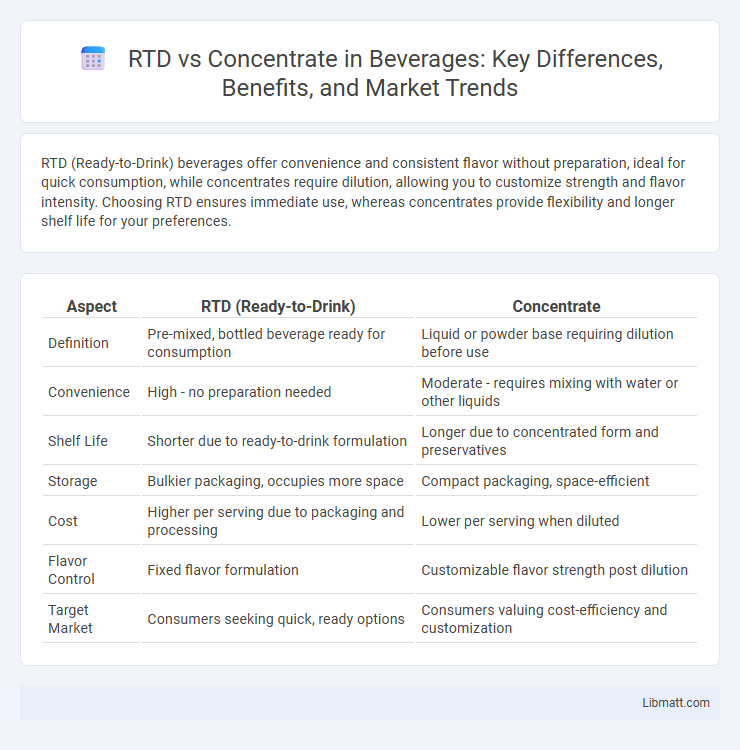RTD (Ready-to-Drink) beverages offer convenience and consistent flavor without preparation, ideal for quick consumption, while concentrates require dilution, allowing you to customize strength and flavor intensity. Choosing RTD ensures immediate use, whereas concentrates provide flexibility and longer shelf life for your preferences.
Table of Comparison
| Aspect | RTD (Ready-to-Drink) | Concentrate |
|---|---|---|
| Definition | Pre-mixed, bottled beverage ready for consumption | Liquid or powder base requiring dilution before use |
| Convenience | High - no preparation needed | Moderate - requires mixing with water or other liquids |
| Shelf Life | Shorter due to ready-to-drink formulation | Longer due to concentrated form and preservatives |
| Storage | Bulkier packaging, occupies more space | Compact packaging, space-efficient |
| Cost | Higher per serving due to packaging and processing | Lower per serving when diluted |
| Flavor Control | Fixed flavor formulation | Customizable flavor strength post dilution |
| Target Market | Consumers seeking quick, ready options | Consumers valuing cost-efficiency and customization |
Introduction to RTD and Concentrate Beverages
Ready-to-drink (RTD) beverages offer convenience by providing pre-mixed drinks that require no preparation, making them ideal for on-the-go consumption. Concentrate beverages, on the other hand, require dilution with water or another liquid before consumption, allowing consumers to control flavor intensity and serving size. Both RTD and concentrate options cater to different preferences in terms of convenience and customization in the beverage market.
Defining RTD (Ready-to-Drink) vs. Concentrate
RTD (Ready-to-Drink) beverages come pre-mixed and packaged for immediate consumption, offering convenience without dilution or preparation. Concentrates are highly concentrated liquids that require dilution with water or other bases before drinking, allowing customization of strength and flavor. Your choice depends on whether you prioritize quick access or control over beverage consistency.
Key Differences: RTD and Concentrate
RTD (Ready-to-Drink) beverages come pre-mixed and packaged for immediate consumption, offering convenience and consistent flavor profiles. Concentrates require dilution before consumption, allowing customization of strength and volume, but involve an extra preparation step. RTDs generally have a shorter shelf life compared to concentrates, which are more stable due to their concentrated form and reduced water content.
Convenience and Preparation Time
Ready-to-drink (RTD) beverages offer unparalleled convenience by eliminating the need for mixing or dilution, allowing you to enjoy your drink straight from the container without any preparation. Concentrate products require additional steps such as measuring, mixing with water, and sometimes chilling, which increases preparation time significantly. Choosing RTD saves you valuable minutes and simplifies your daily routine, especially when on-the-go or during busy schedules.
Shelf Life and Storage Requirements
RTD beverages possess a shorter shelf life, typically ranging from 6 to 12 months, due to their ready-for-consumption format and minimal processing. Concentrates, with reduced water content and concentrated ingredients, offer extended shelf stability often exceeding 12 months when stored in cool, dark environments. Proper storage for RTDs necessitates refrigeration or cool conditions post-opening, while concentrates remain stable at room temperature prior to dilution and use.
Cost Comparison: RTD vs. Concentrate
Ready-to-Drink (RTD) beverages typically incur higher per-unit costs due to packaging, convenience, and branding expenses, whereas concentrates offer a more economical option by requiring dilution, which stretches the product volume. The upfront cost of concentrates is lower, making them ideal for bulk or frequent consumption, but additional expenses like water, labor, and container costs should be factored into the total cost analysis. Consumers prioritizing cost efficiency often prefer concentrates, while those valuing ease of use and immediate consumption may lean toward the more expensive RTD products.
Flavor Variety and Customization
RTD (Ready-to-Drink) options offer a fixed flavor profile tailored for convenience, limiting your ability to customize flavors. Concentrates provide greater flavor variety and control, allowing you to mix and adjust intensity according to personal preference. Choosing concentrates enhances your options for unique and personalized taste experiences.
Environmental Impact and Packaging
RTD beverages generate more packaging waste due to single-use containers but often utilize lightweight, recyclable materials that reduce carbon footprint during transportation. Concentrates require less packaging volume and lower shipping weight, minimizing fuel consumption and emissions over long distances. Choosing RTD or concentrate can impact Your environmental footprint based on packaging recyclability and distribution logistics.
Consumer Preferences and Market Trends
Consumer preferences increasingly favor RTD (Ready-to-Drink) beverages for their convenience, portability, and immediate consumption benefits. Market trends show a surge in demand for RTD products, driven by busy lifestyles and growing interest in innovative flavors and functional ingredients. Your choice between RTD and concentrate depends on whether you prioritize speed and ease or customization and cost-effectiveness.
Choosing the Right Option: RTD or Concentrate
Choosing between Ready-to-Drink (RTD) and concentrate depends on convenience and flavor control. RTD offers instant usage with consistent taste, ideal for quick consumption, while concentrates allow customization of strength and sweetness, making them cost-effective for frequent users. Consider storage space, preparation time, and personal preference to select the best option for your lifestyle.
RTD vs concentrate Infographic

 libmatt.com
libmatt.com